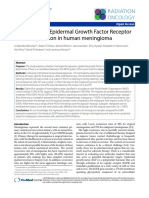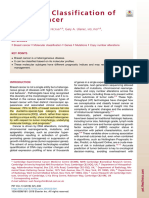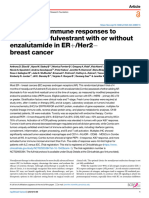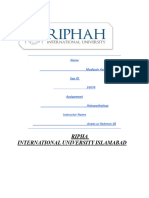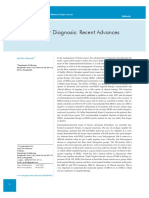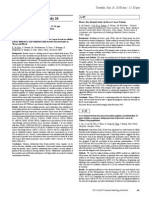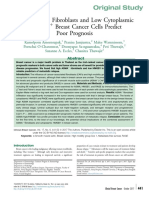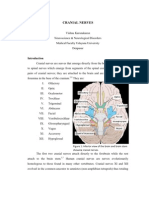0504 NewsPath Breast Carcinoma Markers
0504 NewsPath Breast Carcinoma Markers
Uploaded by
José Mauricio PeñalozaCopyright:
Available Formats
0504 NewsPath Breast Carcinoma Markers
0504 NewsPath Breast Carcinoma Markers
Uploaded by
José Mauricio PeñalozaCopyright
Available Formats
Share this document
Did you find this document useful?
Is this content inappropriate?
Copyright:
Available Formats
0504 NewsPath Breast Carcinoma Markers
0504 NewsPath Breast Carcinoma Markers
Uploaded by
José Mauricio PeñalozaCopyright:
Available Formats
367337416.
doc Page 1 of 2
Prognostic and predictive markers for breast carcinoma
Breast carcinoma is the most common malignancy and the leading cause of
cancer death in women. In this country, there has been a sharp increase in its
detection, largely due to the widespread use of mammography. Despite detection
of smaller (and presumably earlier) disease, the survival rate has improved very
little since the 1930s.
Major prognostic and predictive factors can be important in choosing appropriate
treatment, determining the risk of recurrence and classifying patients for clinical
trials. Below is a review of markers routinely offered by most reference
laboratories.
Estrogen Receptors (ERs) and Progesterone Receptors (PRs): Expression of
ERs and/or PRs within tumors correlates well with low histologic grade and
responsiveness to hormonal manipulation, especially in postmenopausal women.
ERs and PRs are evaluated with immunohistochemistry (IHC) on paraffin
embedded tissue, where staining of cell nuclei is considered positive. The
percentage of cells staining and strength of the stain needed for a positive test is
controversial, so most labs will report the actual percentage of positive cells.
While many agree that 5% is considered positive, tumors with a lower
percentage (1-4%), or even no staining, may show a borderline response to
hormonal therapy. The American Society of Clinical Oncology (ASCO) Tumor
Marker Panel of 1995 concluded: (1) ER and PR should be measured on every
primary breast cancer (and metastatic lesions if it would influence treatment
planning), (2) in metastatic disease, ER and PR positivity supports use of
hormonal therapy, (3) regardless of menopausal status, ER and PR positivity
helps to identify patients likely to benefit for adjuvant hormonal therapy and (4)
ER and PR receptors are weak prognostic indicators and should not be used to
determine whether to treat a patient with adjuvant therapy.
HER2/neu (Immunohistochemistry [IHC] and Fluorescence In-Situ
Hybridization [FISH]): HER2/neu is a proto-oncogene that encodes the
production of HER2, a cell surface protein important in cell regulation.
Abnormalities of HER2/neu occur in 25-30% of breast carcinomas, especially
those that are poorly differentiated, lymph node positive, hormone receptor
negative, flow aneuploid and/or show high proliferation rates.
HER2/neu amplification and protein overexpression can be detected with FISH
and IHC, respectively, both of which can be performed on paraffin-embedded
NewsPath Editor: Megan J. DiFurio, MD, FCAP
This newsletter is produced in cooperation with the College of American Pathologists Public Affairs Committee and may
be reproduced in whole or in part as a service to the medical community. Copyright 2005
367337416.doc Page 2 of 2
tissue. Maximum sensitivity can be achieved by using both methods. HER2
status is used as an eligibility criterion for anti-HER2 immunotherapies, such as
Herceptin. While some studies have shown a positive dose-response effect
with adjuvant chemotherapy for tumors showing gene amplification, elevated
HER2 may actually be a negative predictor of response to adriamycin-based
chemotherapy.
Measures of Tumor Cell Proliferation Rate: Proliferation can be measured by
flow cytometry (S-phase fraction), thymidine labeling index, mitotic counts or IHC
detection of cellular proteins (e.g. Ki-67/MIB-1). Most evidence supports that
tumors with a high proliferation rate have a worse prognosis. Manual mitotic
counts have shown to be an important part of the standard grading system
(Scarff-Bloom-Richardson).
Nonetheless, the best technique to use remains unclear as it has not been
determined which can be most accurately measured and will provide results that
correlate well with overall survival.
DNA Ploidy: DNA content in cells can be determined by flow cytometry, image
analysis or laser scanning cytometry. Aneuploid DNA content has been shown to
be associated with a worse prognosis, but it is uncertain whether this parameter
adds independent information of prognostic value.
Other Molecular Markers: Mutation of p53, an oncosuppressor gene, causes
variant p53 proteins to have an increased half-life, thus accumulating in the cell.
These excess proteins can be detected with IHC in about 90% of cases by
increased nuclear staining. Although over accumulation of p53 protein has been
associated with shortened survival in breast carcinoma patients, it also correlates
with cell proliferation and thus may not be an independent prognostic factor.
Epidermal growth factor receptor (EGFR) is related to HER2/neu and can be
detected with IHC. The expression of EGFR is associated with shorter survival,
but there is very little evidence to support its routine use at this time.
At a minimum, hormone receptor and HER2 status should be determined for
every new breast cancer diagnosis. These tests are, of course, in addition to
major prognostic factors such as axillary lymph node status, tumor size and
distant metastasis (the basis of clinical staging), as well as tumor grade and
lymph vascular invasion.
NewsPath Editor: Megan J. DiFurio, MD, FCAP
This newsletter is produced in cooperation with the College of American Pathologists Public Affairs Committee and may
be reproduced in whole or in part as a service to the medical community. Copyright 2005
You might also like
- Chemo Chart Final 121509Document7 pagesChemo Chart Final 121509José Mauricio Peñaloza100% (5)
- Cessna 206&T206 1969-1976 MM D2007-3-13 PDFDocument542 pagesCessna 206&T206 1969-1976 MM D2007-3-13 PDFchap20277100% (1)
- Lab Report Soil Sand Replacement MethodDocument8 pagesLab Report Soil Sand Replacement MethodAnonymous Z9aGNzG71% (28)
- Orientation Jaw RelationDocument57 pagesOrientation Jaw RelationAatish Dilip Shah100% (1)
- Kundalini_ The Ultimate Guide to Awakening Your Chakras Through Kundalini Yoga and Meditation and to Experiencing Higher Consciousness, Clairvoyance, Astral Travel, Chakra Energy, and Psychic Visions ( PDFDrive.com.pdfDocument81 pagesKundalini_ The Ultimate Guide to Awakening Your Chakras Through Kundalini Yoga and Meditation and to Experiencing Higher Consciousness, Clairvoyance, Astral Travel, Chakra Energy, and Psychic Visions ( PDFDrive.com.pdfselvarajan govindarajan75% (4)
- Biomarkers in Breast Cancer 2024: An Updated Consensus Statement by The Spanish Society of Medical Oncology and The Spanish Society of PathologyDocument17 pagesBiomarkers in Breast Cancer 2024: An Updated Consensus Statement by The Spanish Society of Medical Oncology and The Spanish Society of PathologyellyanaperwitasariNo ratings yet
- Sabcs 2014 AllabstractsDocument1,508 pagesSabcs 2014 Allabstractsrajesh4189No ratings yet
- Shnitt and Jacobs AJCP 2000Document5 pagesShnitt and Jacobs AJCP 2000Vukosava Milic TorresNo ratings yet
- MMC 1Document44 pagesMMC 1Annisya MaharaniNo ratings yet
- Current Issues in ER and HER2 Testing by IHC in Breast CancerDocument8 pagesCurrent Issues in ER and HER2 Testing by IHC in Breast CancerOncology FatmawatiNo ratings yet
- JCM 09 01083 v3Document15 pagesJCM 09 01083 v3Smit ShahNo ratings yet
- Editorial: Lung Cancer: Prevalent Trends & Emerging ConceptsDocument3 pagesEditorial: Lung Cancer: Prevalent Trends & Emerging Conceptsjeevan georgeNo ratings yet
- Rakha Et Al. 2006 Prognostic Markers in Triple Negative Breast CancerDocument8 pagesRakha Et Al. 2006 Prognostic Markers in Triple Negative Breast CancerdanishNo ratings yet
- 1 s2.0 S003130251640365X MainDocument9 pages1 s2.0 S003130251640365X MainbrendaNo ratings yet
- PD-L1 Expression in Triple-Negative Breast Cancer: Research ArticleDocument14 pagesPD-L1 Expression in Triple-Negative Breast Cancer: Research ArticleFebrian Parlangga MuisNo ratings yet
- Cancer - January 1994 - Mansour - Prognostic Factors in Early Breast CarcinomaDocument20 pagesCancer - January 1994 - Mansour - Prognostic Factors in Early Breast Carcinomarstu.budimulyaNo ratings yet
- Immunohistochemical and Molecular Evaluation of Oncoprotein HER-2 in Women's Breast Cancer in The Republic of CongoDocument9 pagesImmunohistochemical and Molecular Evaluation of Oncoprotein HER-2 in Women's Breast Cancer in The Republic of CongoScivision PublishersNo ratings yet
- 1 s2.0 S0147027222000551 MainDocument19 pages1 s2.0 S0147027222000551 MaincatiadefrancaNo ratings yet
- Prognostic and Predictive Factors Revisited: BreastDocument7 pagesPrognostic and Predictive Factors Revisited: BreastAndersson SaenzNo ratings yet
- EGFR in MEningiomaDocument7 pagesEGFR in MEningiomaApriyanto LatiefNo ratings yet
- JPTM 2019 02 08Document8 pagesJPTM 2019 02 08m8f5mwpzwyNo ratings yet
- Godone 2018Document21 pagesGodone 2018Roberta GodoneNo ratings yet
- Molecular Classification of BCDocument14 pagesMolecular Classification of BCbrendaNo ratings yet
- Clinical and immune responses to neoadjuvant fulvestrant with or without enzalutamide in ERHer2− breast cancerDocument14 pagesClinical and immune responses to neoadjuvant fulvestrant with or without enzalutamide in ERHer2− breast cancersuranitcha125No ratings yet
- JOURNAL Breast CancerDocument10 pagesJOURNAL Breast CancerAndy SelvianNo ratings yet
- Histopathology AssinmentDocument7 pagesHistopathology AssinmentAnees RahmanNo ratings yet
- 343582Document9 pages343582Vamsee SettivariNo ratings yet
- EndoPredict TechnicalSpecificationsDocument2 pagesEndoPredict TechnicalSpecificationscarlosNo ratings yet
- Oncolo 11 1 1Document8 pagesOncolo 11 1 1dini nurfauziaNo ratings yet
- Prognostic Value of p53 Gene in Ovarian Cancer: - Maj Obstet 172 Rauf Dan Masadah Ginekol IndonesDocument5 pagesPrognostic Value of p53 Gene in Ovarian Cancer: - Maj Obstet 172 Rauf Dan Masadah Ginekol IndonesDini MedyaniNo ratings yet
- Tumor Markers: Universiti Kuala Lumpur (Unikl) - Where Knowledge Is Applied and Dreams RealizedDocument29 pagesTumor Markers: Universiti Kuala Lumpur (Unikl) - Where Knowledge Is Applied and Dreams RealizedNida RidzuanNo ratings yet
- 46 FullDocument7 pages46 FullAnctho LukmiNo ratings yet
- Medi 98 E15449Document7 pagesMedi 98 E15449m8f5mwpzwyNo ratings yet
- NIH Public Access: Author ManuscriptDocument18 pagesNIH Public Access: Author Manuscriptaaasim93No ratings yet
- Faculty of Pharmacy, AIMST University, Semeling, Bedong, Malaysia-08100Document7 pagesFaculty of Pharmacy, AIMST University, Semeling, Bedong, Malaysia-08100Anonymous 51JDhTNCNo ratings yet
- Annals of Diagnostic Pathology: Gerard Nuovo, MDDocument6 pagesAnnals of Diagnostic Pathology: Gerard Nuovo, MDamelia zettaNo ratings yet
- Association of The p53 or GSTM1 Polymorphism With The Risk of Nasopharyngeal Carcinoma: A Meta AnalysisDocument8 pagesAssociation of The p53 or GSTM1 Polymorphism With The Risk of Nasopharyngeal Carcinoma: A Meta AnalysisontabarkerNo ratings yet
- Ovarian Cancer ThesisDocument8 pagesOvarian Cancer ThesisDon Dooley100% (1)
- Advances in The Molecular Taxonomy of Breast CancerDocument7 pagesAdvances in The Molecular Taxonomy of Breast CancerbrendaNo ratings yet
- CLEOPATRA Biomarker Analysis - ProtocolDocument117 pagesCLEOPATRA Biomarker Analysis - ProtocolweilinmdNo ratings yet
- Article WJPR 1517982667Document15 pagesArticle WJPR 1517982667NishaNo ratings yet
- Principles of Oncology and Outline of ManagementDocument78 pagesPrinciples of Oncology and Outline of ManagementPavan JonnadaNo ratings yet
- The Changing Role of Pathology in Breast Cancer Diagnosis and TreatmentDocument17 pagesThe Changing Role of Pathology in Breast Cancer Diagnosis and TreatmentFadli ArchieNo ratings yet
- Breast Cancer Diagnosis: Recent Advances: MD Zillur RahmanDocument2 pagesBreast Cancer Diagnosis: Recent Advances: MD Zillur Rahmannadila raudhani pNo ratings yet
- Molecular Diagnosis in Breast Cancer: Mini-Symposium: Breast PathologyDocument12 pagesMolecular Diagnosis in Breast Cancer: Mini-Symposium: Breast PathologyOber Van Gómez LópezNo ratings yet
- Review Article On Breast CancerDocument9 pagesReview Article On Breast CancerMehtab AhmedNo ratings yet
- Galectin CancerDocument6 pagesGalectin CancermaniiiiiiiiNo ratings yet
- Breast Cancer and Biomedical Informatics: The Prognochip ProjectDocument6 pagesBreast Cancer and Biomedical Informatics: The Prognochip ProjectRuanita VeigaNo ratings yet
- Jamona, JiaDocument4 pagesJamona, JiaJia G. JAMONANo ratings yet
- Ol 27 2 14210 PDFDocument11 pagesOl 27 2 14210 PDFafzaahmad212No ratings yet
- Pediatricneuro-Oncology: Fatema MalbariDocument17 pagesPediatricneuro-Oncology: Fatema MalbariRandy UlloaNo ratings yet
- Cancer BiomarkersDocument7 pagesCancer Biomarkersmaheen_aslam6596No ratings yet
- Breast Cancer Prognosis PrognosisDocument3 pagesBreast Cancer Prognosis PrognosisNajwa AbdullahNo ratings yet
- 9.lecturer 18 Biochemistry Effect On Tumor and Tumor MarkersDocument19 pages9.lecturer 18 Biochemistry Effect On Tumor and Tumor MarkersAbdulRahman MuthannaNo ratings yet
- Tumor Marker General Principles and Guidelines (S.sharma 2013)Document8 pagesTumor Marker General Principles and Guidelines (S.sharma 2013)Ria DeviNo ratings yet
- Triple Negative Breast Cancer - An Overview - PMCDocument9 pagesTriple Negative Breast Cancer - An Overview - PMChxmm8v4sjmNo ratings yet
- Impact of Eukaryotic Translation Initiation FactorDocument19 pagesImpact of Eukaryotic Translation Initiation FactorMilorad ZjalićNo ratings yet
- Concept Paper MiRNA in CA BreastDocument10 pagesConcept Paper MiRNA in CA BreastRajinder ChawlaNo ratings yet
- Tripleneg Gazinska Modpathol 2013Document12 pagesTripleneg Gazinska Modpathol 2013ThormmmNo ratings yet
- Breast CancerDocument46 pagesBreast CancerdokteraanNo ratings yet
- Breast Cancer - 2021Document20 pagesBreast Cancer - 2021Gilbert LazarusNo ratings yet
- Expression of Mirnas and Pten in Endometrial Specimens Ranging From Histologically Normal To Hyperplasia and Endometrial AdenocarcinomaDocument9 pagesExpression of Mirnas and Pten in Endometrial Specimens Ranging From Histologically Normal To Hyperplasia and Endometrial AdenocarcinomaFerdina NidyasariNo ratings yet
- Plasma DNA Integrity Index in Breast Cancer PatientsDocument19 pagesPlasma DNA Integrity Index in Breast Cancer PatientsSalwa Hassan TeamaNo ratings yet
- 28533055: High ASMA Fibroblasts and Low Cytoplasmic HMGB1 Breast Cancer Cells Predict Poor PrognosisDocument14 pages28533055: High ASMA Fibroblasts and Low Cytoplasmic HMGB1 Breast Cancer Cells Predict Poor PrognosisNazmi ZegarraNo ratings yet
- Breast Disease: Diagnosis and Pathology, Volume 1From EverandBreast Disease: Diagnosis and Pathology, Volume 1Adnan AydinerNo ratings yet
- SABCS 2013 Recommended Abstracts: New Data On Breast Cancer Therapies Kimberly L Blackwell MDDocument2 pagesSABCS 2013 Recommended Abstracts: New Data On Breast Cancer Therapies Kimberly L Blackwell MDJosé Mauricio PeñalozaNo ratings yet
- Systemic Therapy Selection in MCRCDocument27 pagesSystemic Therapy Selection in MCRCJosé Mauricio PeñalozaNo ratings yet
- Rules Update Guide 2015Document3 pagesRules Update Guide 2015José Mauricio PeñalozaNo ratings yet
- Colon Cancer:: Pfizer Headquarter Office. Wednesday 18/02/2015Document92 pagesColon Cancer:: Pfizer Headquarter Office. Wednesday 18/02/2015José Mauricio PeñalozaNo ratings yet
- Management of Kaposi'S Sarcoma Associated With Human Immunodeficiency Virus InfectionDocument21 pagesManagement of Kaposi'S Sarcoma Associated With Human Immunodeficiency Virus InfectionJosé Mauricio PeñalozaNo ratings yet
- Fiat - Q Interpersonal Relationships Questionnaire: Class A: Assertion of Needs (Identification & Expression)Document5 pagesFiat - Q Interpersonal Relationships Questionnaire: Class A: Assertion of Needs (Identification & Expression)Vikramadithyan VikyNo ratings yet
- Biotech Companies in PuneDocument3 pagesBiotech Companies in PuneShivaji Mohite85% (13)
- Assignment Embryology - Docx BRESHDocument6 pagesAssignment Embryology - Docx BRESHkarimibrenda99No ratings yet
- PM Bizhub 222 282 362Document100 pagesPM Bizhub 222 282 362Andrey KhodanitskiNo ratings yet
- Nama Obat Dosis Tablet U/ Puyer 10 Bks (3 HR) Dosis Dewasa 20kgDocument2 pagesNama Obat Dosis Tablet U/ Puyer 10 Bks (3 HR) Dosis Dewasa 20kgrakhmawati diyanaNo ratings yet
- Module 6 - Philippine E-Health Strategic Plan (PeHSP) and Philippine Health Information Exchange (PHIE)Document19 pagesModule 6 - Philippine E-Health Strategic Plan (PeHSP) and Philippine Health Information Exchange (PHIE)Zuriel San PedroNo ratings yet
- Duroflex 1K: Product Data SheetDocument4 pagesDuroflex 1K: Product Data SheetVaittianathan MahavapillaiNo ratings yet
- Protecting Individual Rights: Natalie Cole 3CDocument6 pagesProtecting Individual Rights: Natalie Cole 3CD JNo ratings yet
- Performance Appraisal at BhelDocument5 pagesPerformance Appraisal at BhelMegha SaxenaNo ratings yet
- JNCT Au3tech Cleaning Machine Instruction ManualDocument49 pagesJNCT Au3tech Cleaning Machine Instruction ManualDianaCarolinaChimoyPecheNo ratings yet
- Meditation TechniqueDocument9 pagesMeditation TechniqueMahender Singh GriwanNo ratings yet
- Soch-4 7 Klass 1Document2 pagesSoch-4 7 Klass 1Евгений МатеровNo ratings yet
- Business Plan FOR: Division of Bataan Morong National High School Senior High School Sabang Morong BataanDocument12 pagesBusiness Plan FOR: Division of Bataan Morong National High School Senior High School Sabang Morong BataanIvan RemegioNo ratings yet
- Miscarriage: - Nur Farhanah Binti Syed Abu Thahir - Hema Latha A/P Manickam - Fathin Fahrieza Binti Mohd AtanDocument33 pagesMiscarriage: - Nur Farhanah Binti Syed Abu Thahir - Hema Latha A/P Manickam - Fathin Fahrieza Binti Mohd AtanIsmail FaruqiNo ratings yet
- Detection of Proteolytic Enzymes in Soursop (Anonna Muricata) Extract by Measuring The Water Holding Capacity of Raw Chicken MeatDocument15 pagesDetection of Proteolytic Enzymes in Soursop (Anonna Muricata) Extract by Measuring The Water Holding Capacity of Raw Chicken MeatRisha Ann CortesNo ratings yet
- THK - Special Plumbing FixtureDocument1 pageTHK - Special Plumbing Fixturesrpk serverNo ratings yet
- CBSE Class 10 Geography Chapter 4 Notes - AgricultureDocument12 pagesCBSE Class 10 Geography Chapter 4 Notes - Agriculturegisbhairupa746No ratings yet
- Fundamental of GeneticsDocument29 pagesFundamental of Geneticsjhun lopezNo ratings yet
- Figure 1: Inferior View of The Brain and Brain Stem Showing Cranial NervesDocument40 pagesFigure 1: Inferior View of The Brain and Brain Stem Showing Cranial NervesVishnu Karunakaran0% (1)
- Contact Everyone: Send SMS AnywhereDocument19 pagesContact Everyone: Send SMS AnywhereAhimbisibwe BakerNo ratings yet
- Health Promotion of Young AdultsDocument72 pagesHealth Promotion of Young AdultsChhavi ShahNo ratings yet
- ZPK With Divider - PatternDocument10 pagesZPK With Divider - Pattern6sw7csc4t4No ratings yet
- Roe V Howard 2019febDocument14 pagesRoe V Howard 2019febEmilyNo ratings yet
- AIA Travel PA Plus Brochure 030123Document21 pagesAIA Travel PA Plus Brochure 030123Navin IndranNo ratings yet
- Picart vs. SmithDocument1 pagePicart vs. SmithNicole Dagohoy Taytayan100% (1)
- Domestic RobotDocument58 pagesDomestic RobotAshMere MontesinesNo ratings yet



















